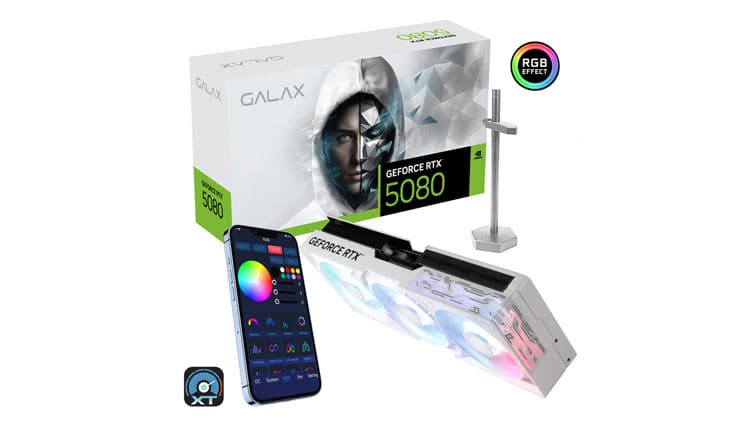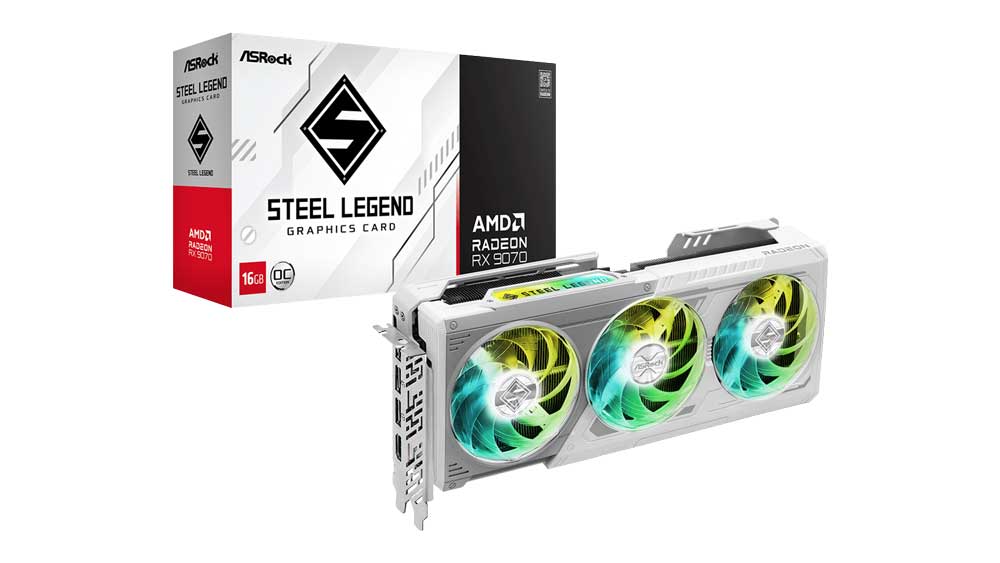The RTX 50 series is here and thankfully thanks to our good friends in Galax, we have the RTX 5080 on the testbench. Read the full review to learn more about the new features of the RTX 50 line and the RTX 5080 performance.
During CES 2025, NVIDIA announced the GeForce RTX 5000 series, and its CEO was super excited to share with us the performance improvements AI offers to gaming. This is the first time that AI has provided such an improvement in gaming, and NVIDIA has fully exploited its capabilities to lure games into the next era of gaming. There was a lot of criticism about whether the performance improvement through the AI-generated frames is actual, and we will find out this through this review, so stay with us!
According to NVIDIA, neural rendering is the next era of computer graphics. By integrating neural networks into the rendering process, NV states that it can provide dramatic leaps forward in performance, image quality, and interactivity to deliver new levels of immersion. The first example of neural rendering was DLSS:
We used lower-resolution rendered frames as input to a neural network, which was trained to output a full-resolution frame. DLSS has since evolved to the point where it can generate entire frames and understand the composition of a scene, including shadows, reflections, and occlusion, to generate images that are often better than native rendering. With the invention of DLSS 4 with Multi Frame Generation, working in unison with the complete suite of DLSS technologies, we can multiply frame rates by up to 8X over traditional brute-force rendering and provide image quality that is often better than native rendering.
But DLSS is just the beginning.
We’ve integrated neural networks inside of programmable shaders to create neural shaders. RTX Neural Shaders will drive the next decade of graphics innovations. They can be used to compress textures by up to 7X, saving massive amounts of graphics memory. It can also be used to create cinematic-quality textures and even more advanced lighting effects in games.
RTX Neural Faces offers an innovative, new approach to improve face quality using generative AI. Instead of traditional rendering, Neural Faces takes a simple rasterized face plus 3D pose data as input and uses a real-time generative AI model to infer a more natural face.
The tables below show the specs of the RTX 50/40 series and AMD models.
NVIDIA Graphics Cards Major Specs
RTX 50 Series
| RTX 5090 | RTX 5080 | RTX 5070 Ti | RTX 5070 | |
|---|---|---|---|---|
| Architecture | GB202 | GB203 | GB203 | GB205 |
| Process Technology | TSMC 4N | TSMC 4N | TSMC 4N | TSMC 4N |
| Base Clock (MHz) | 2010 | 2300 | 2300 | 2160 |
| Boost Clock (MHz) | 2410 | 2620 | 2450 | 2510 |
| VRAM Size (GB) | 32 | 16 | 16 | 12 |
| VRAM Type | GDDR7 | GDDR7 | GDDR7 | GDDR7 |
| VRAM Speed (Gbps) | 28 | 30 | 28 | 28 |
| VRAM Bus Width (bit) | 512 | 256 | 256 | 192 |
| Transistors (Billions) | 92.2 | 45.6 | 45.6 | 31.0 |
| Shading Units | 21760 | 10752 | 8960 | 6144 |
| TMUs/Tensor Cores | 680 | 336 | 280 | 192 |
| ROPs | 176 | 128 | 96 | 64 |
| SM/RT Cores | 170 | 84 | 40 | 48 |
| TDP (W) | 575 | 360 | 300 | 250 |
| Launch Month/Year | 1/2025 | 1/2025 | 1/2025 | 1/2025 |
| MSRP ($) | 2000 | 1000 | 750 | 550 |
RTX 40 Series
| RTX 4090 | RTX 4080 Super | RTX 4070 Ti Super | RTX 4070 Super | RTX 4070 | RTX 4060 Ti | |
|---|---|---|---|---|---|---|
| Architecture | AD102 | AD103 | AD103 | AD104 | AD104 | AD106 |
| Process Technology | TSMC 5N | TSMC 5N | TSMC 5N | TSMC 5N | TSMC 5N | TSMC 5N |
| Base Clock (MHz) | 2235 | 2295 | 2340 | 1980 | 1920 | 2310 |
| Boost Clock (MHz) | 2520 | 2550 | 2610 | 2475 | 2475 | 2535 |
| VRAM Size (GB) | 24 | 16 | 16 | 12 | 12 | 8 |
| VRAM Type | GDDR6X | GDDR6X | GDDR6X | GDDR6X | GDDR6X | GDDR6 |
| VRAM Speed (Gbps) | 21 | 23 | 21 | 21 | 21 | 18 |
| VRAM Bus Width (bit) | 384 | 256 | 256 | 192 | 192 | 128 |
| Transistors (Billions) | 76.3 | 45.9 | 45.9 | 35.8 | 35.8 | 22.9 |
| Shading Units | 16384 | 10240 | 8448 | 7168 | 5888 | 4352 |
| TMUs/Tensor Cores | 512 | 320 | 264 | 224 | 184 | 136 |
| ROPs | 176 | 112 | 96 | 80 | 64 | 48 |
| SM/RT Cores | 128 | 80 | 66 | 56 | 46 | 34 |
| TDP (W) | 450 | 320 | 285 | 220 | 200 | 160 |
| Launch Month/Year | 9/22 | 1/2024 | 1/24 | 1/24 | 4/23 | 4/23 |
| Street Price ($) | 2500 | 1600 | 915 | 640 | 570 | 399 |
The table below contains the specs of AMD’s current-generation graphics cards for reference purposes.
AMD Graphics Cards Major Specs
| RX 7900 XTX | RX 7900 XT | RX 7900 GRE | Sapphire Radeon RX 7900 GRE | RX 7800 XT | RX 7700 XT | |
|---|---|---|---|---|---|---|
| Architecture | Navi 31 | Navi 31 | Navi 31 | Navi 31 | Navi 32 | Navi 32 |
| Process Technology | TSMC N5/N6 | TSMC N5/N6 | TSMC N5/N6 | TSMC N5/N6 | TSMC N5/N6 | TSMC N5/N6 |
| Base Clock (MHz) | 1929 | 1387 | 1880 | 1972 | 1295 | 1435 |
| Boost Clock (MHz) | 2498 | 2394 | 2245 | 2333 | 2430 | 2544 |
| VRAM Size (GB) | 24 | 20 | 16 | 16 | 16 | 12 |
| VRAM Type | GDDR6 | GDDR6 | GDDR6 | GDDR6 | GDDR6 | GDDR6 |
| VRAM Speed (Gbps) | 20 | 20 | 18 | 18 | 19.5 | 18 |
| VRAM Bus Width (bit) | 384 | 320 | 256 | 256 | 256 | 192 |
| Transistors (Billions) | 57.7 | 57.7 | 57.7 | 57.7 | 28.1 | 28.1 |
| Shading Units | 6144 | 5376 | 5120 | 5120 | 3840 | 3456 |
| TMUs | 384 | 336 | 320 | 320 | 240 | 216 |
| ROPs | 192 | 192 | 160 | 160 | 96 | 96 |
| Compute Units | 96 | 84 | 80 | 80 | 60 | 54 |
| Ray Tracing Cores | 96 | 84 | 80 | 80 | 60 | 54 |
| TDP (W) | 355 | 300 | 250 | 250 | 263 | 245 |
| Launch Month/Year | 11/22 | 11/22 | 7/23 | 2/24 | 8/23 | 8/23 |
| Street Price ($) | 930 | 750 | 550 | 570 | 500 | 420 |
- CUDA Cores: 10752
- Boost Clock: 2625MHz
- 1-Click OC Clock: 2640MHz (by installing Xtreme Tuner Plus Software and using 1-Click OC)
- Memory Speed: 30 Gbps
- Standard Memory Config: 16 GB
- Memory Interface Width 256-bit GDDR7
- Memory Bandwidth: 960 GB/sec
- PCI-E 5.0
- Fans: 3x 92mm
- Fan Stop: Yes
- Ports: 3x DisplayPort 2.1b, 1x HDMI 2.1b
- Dimensions(with Bracket): 315 * 140.5 * 50.7mm
- Dimensions(without Bracket): 303 * 125 * 49.7mm (NVIDIA SFF-Ready)
- Weight: 1313gr
- Warranty: two years
- MSRP (excluding VAT): $1000
- Prologue & Technical specifications
- NVIDIA’s Key Technologies
- Box & Contents
- Part Analysis
- Specifications Comparison
- Test System
- Game Benchmark Details
- Raster Performance
- RT Performance
- RT Performance + DLSS/FSR Balanced
- Raytracing Performance + DLSS/FSR Balanced + FG
- DLSS/FSR Balanced (No RT)
- DLSS/FSR Balanced + FG (No RT)
- Relative Perf & Perf Per Watt (Raster)
- Relative Perf & Perf Per Watt (Raster + DLSS/FSR)
- Relative Perf & Perf Per Watt (RT)
- Relative Perf & Perf Per Watt (RT + DLSS/FSR)
- Relative Perf & Perf Per Watt (RT + DLSS/FSR + FG)
- Rendering Performance
- Operating Temperatures
- Operating Noise & Frequency Analysis
- Power Consumption
- Clock Speeds & Overclocking
- Cooling Performance
- Epilogue



why dont you report on coil whine? i care about that more than anything else
Εξαιρετική παρουσίαση της RTX 5080 καρτας γραφικων! Οπως ειπωθηκε σωστα στο βιντεο εδω δεν βλεπουμε μια νεα καρτα απο θεμα επιδοσεων hardware,αλλα απο θεμα νεου software! Οπως τοτε με τη 7000 Gen της Radeon με απιστευτη αυξηση FPS μεσω του Fidelity 3 ετσι και τωρα βλεπουμε μια νεα gen στο θεμα DLSS4 και τιποτα παραπανω!
Aris i have an Andyson PX-1200 Platinum with ATX 2.53 spec should it okay to handle RTX 5080 with 12v-2×6 converter ?
power wise is ok, but I don’t trust adapters/converters.
did the 12v-2×6 converter still had bad melting behavior in RTX 50xx series with high wattage PSU like 1000W++, and do you have any suggestion for ATX 2.53 users who want to pairs their PSU with RTX 50xx series ?
There will always be issues in everything, but the fact is that 12V-2×6 is much safer than 12VHPWR. As for ATX 2.53 users, get proper cables from the respective brands, 2x 8-pin to 12+4